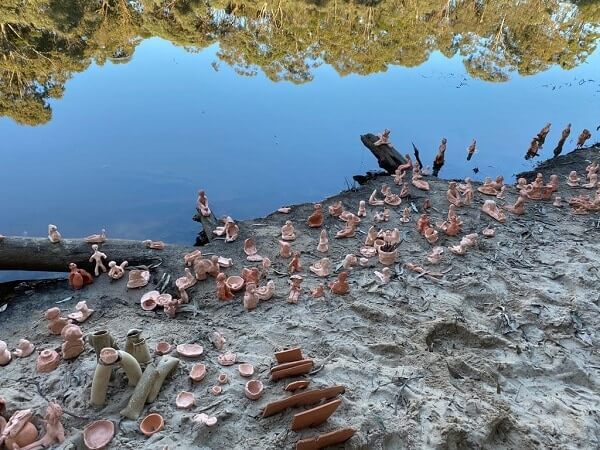When my family first immigrated to Australia in 1994, it was in Warwick Farm where we first dropped our worn bags and surrendered our fate to this new and unknown land. I still recall walking along the banks of the Georges River as a 5-year-old, marvelling at the bright green surrounds and itching to play on the swings! So, 28 years later, when I was presented with the unmissable opportunity to join The River Project as part of the 24th Biennale of Sydney, I knew it would be special.
Curated and co-directed by Jiva Parthipan and Sally Sussman, The River Project expresses how indigenous and other communities reimagine the land and their waterways in everyday life and living. For Jiva Parthipan, The River Project was dedicated to a personal loss experienced, which prompted him to explore this facet of our landscape.
The afternoon was glorious – sun blazing but a crisp wind nipping at exposed faces whilst we stood on the original land of the Tharawal people. The Welcome to Country by Dharug Elder and artist Julie Bukari was followed by a very special welcome dance by the Jannawi Dance Clan lead by Peta Strachan. We were offered the chance to be ritually cleansed of all our worries and anxieties, and as the eucalyptus branch passed over our heads, I felt a quiet calm descend on the crowd. The walk led us physically along the riverbank but metaphysically back in time along a multicultural path of the history of the River, and its importance in many cultures.

From the soulful vibrations of the didgeridoo, we transitioned to the evocative notes of the Indian flute played by Venkhatesh Sritharan. Dancers Sowmya Sriram and Vishakha Iyer traced the morning ritual of cleansing the home and drawing patterns on the floor with rice flour which also sustains the many insects in our environment.

Vidya Gokul and Sneha Rao portrayed the scene of village women washing and dyeing their clothes by the riverbank. Both these segments depicting the river as a life force were magical to witness.

As the pied piper led the crowd onwards with his flute, we encountered the Jannawi Dance Clan who weaved stories of land, flora and fauna through their synchronised and surreal movements. We heard from Rooan Al Kamashi about the role of fresh flowing water (Yardena) in the Mandean community – both in life (baptism) and death rituals. I was one of the lucky few to place a small handmade ceramic sculpture by the riverbank as part of an exhibit presented by Yuhana Nashmi and Afnan Amoor with the Mandean community.

In a highlight Commitment Ceremony, we placed our hands in the white ochre and touched the tree (ironically with its branches all cut off), and made a pledge to protect the land we called home.

The reverie was broken by the whoop of children delighted by the skilful acrobatic movements of the barefoot water skiers of the NSW Barefoot Water Ski Club whizzing by. Rob Dixon, the Georges Riverkeeper, presented an interesting perspective of our commitment to keeping the river clean.

The haunting harmony of the didgeridoo underscoring Carnatic and Mandean singing accompanied us back to the site of the finale, depicted by the Samskriti dancers led by their director Hamsa Venkat, and musicians Venkhatesh (flute), Namrata Pulapaka (Carnatic vocals) and Amey Uppal (percussion). The Georges River was transformed into the river Ganga; the fire crackling in the water and the dancers shadows flitting across the audience’s faces led us to a state of transcendence.
The ceremony of the Riverwalk was closed by the Jannawi Clan Dancers who left us sitting in awed silence, each one of us too afraid to be the first to break the spell. I felt on that day, much like the walk, I had come full circle – back to the river and the land on which I started my life in Australia.
Images: Paul Van Reyk, Uma Sriram
READ ALSO: Jiva Parthipan’s ‘Stories of Kannagi’ wins at Blake Prize for religious art





